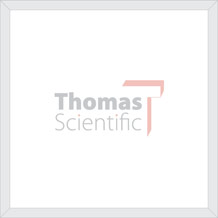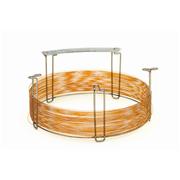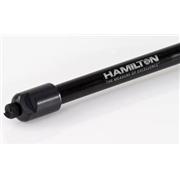Chemicals, GC
Benchmark BenchPress 2024 - Promos & Lab Favorites
Shakers, Incubators, Centrifuges, Balances, Rotators,
Vortexers, Dry Baths, Rockers and MORE!
Download the promotional brochure below learn more.
![]() Benchmark BenchPress 2024 Promotional Brochure
Benchmark BenchPress 2024 Promotional Brochure
Offers expire July 31, 2024
-
Cartridge Replacement PRP-X200 Pk5
HamiltonAnalyze inorganic and organic cations using conductivity or UV detection. Separate mono or divalent cations depending on mobile phase conditions from 20 ppb to 200 ppm. Replacement Cartridge Stainless Steel Particle size: 10 µm
-
Dbht-Simd 5m, 0.53mm, 0.15um
Agilent Technologies100% Dimethylpolysiloxane “Boiling point” phase for high temperature simulated distillation Durable stainless steel tubing 430°C upper temperature limit Distillation range of C6 to C110 Low bleed - even at 430°C Bonded and cross-linked Solvent…
-
DB-5ms
Agilent TechnologiesPhenyl Arylene polymer virtually equivalent to a (5%-Phenyl)-methylpolysiloxane Non-polar Very low bleed, suitable for GC/MS Exhibits inertness to active compounds Temperature limits are -60° to 325°/350°C Improved signal-to-noise ration for increased sensitivity and mass…
-
Undeactivated Fused Silica Tubing
Agilent TechnologiesUndeactivated tubing or bare fused silica is commonly used for capillary electrophoresis. It can also be used for transfer lines and other applications where inertness is not critical. Agilent Technologies products are intended for sale/shipment within the US only. International customers…
-
DB-35
Agilent Technologies(35%-Phenyl)-methylpolysiloxane Midpolarity - slightly more polar than HP-35 Low bleed Inert to active solutes Ideal for confirmational analyses Bonded and cross-linked Solvent rinsable Equivalent to USP Phase G42 Similar Phases: Rtx-35, SPB-35, AT-35,…
-
HP-1ms
Agilent Technologies100% Dimethylpolysiloxane Identical selectivity to HP-1 Non-polar Low bleed characteristics General purpose column Improved signal-to-noise ratio for better sensitivity and mass spectral integrity Bonded and cross-linked Solvent rinsable Temperature range:…
-
GC Capillary Column
Agilent TechnologiesAgilent J&W DB-1 is nonpolar and low-bleed, and operates under high temperature limits. It is an excellent choice for general purpose use in a wide variety of applications. Precision-engineered DB-1 is bonded, crosslinked and solvent rinsable, and is equivalent to USP phase G2. This product is…
-
DB-1ms
Agilent Technologies100% Dimethylpolysiloxane Identical selectivity to DB-1 Non-polar Very low bleed characteristics, ideal for GC/MS Improved acid performance compared to standard 100% Dimethylpolysiloxane columns Improved signal-to-noise ratio for better sensitivity and mass spectral integrity …
-
 DB-5.625
Agilent Technologies
DB-5.625
Agilent TechnologiesEquivalent to a (5%-Phenyl)-methylpolysiloxan Non-polar Specially processed to exhibit excellent inertness for EPA Semivolatiles Methods 625, 1625, 8270 and CLP protocols* Surpasses EPA performance criteria for semivolatiles Inert for base, neutral and acidic compounds High…
-
HP-35
Agilent Technologies(35%-Phenyl)-methylpolysiloxane Midpolarity - slightly less polar than DB-35 Inert to active solutes Ideal for confirmational analyses Bonded and cross-linked Solvent rinsable Equivalent to USP Phase G42 Similar Phases: Rtx-35, SPB-35, AT-35, Sup-Herb, DB-35,…
-
HP-5
Agilent Technologies(5%-Phenyl)-methylpolysiloxane Non-polar Wide range of applications High temperature limits: -60° to 325°C isothermally, -60° to 350°C programmed. -60° to 300°C isothermally, -60° to 320°C programmed for 0.53 mm columns -60° to 260°/280°C…
-
DB-5 And DB-5ms
Agilent TechnologiesGC capillary columns are typically wound on 7 inch cages that fit into standard-sized GCs like the 6890. The 6850 GC has a smaller oven which requires the use of columns wound on a smaller cage diameter. DB-5 (2713R99, T86, T94 and V89) (5%-Phenyl)-methylpolysiloxane Non-polar …
-
Ultra 1 & Ultra 2
Agilent TechnologiesUltra 1: 100% Dimethylpolysiloxane Ultra 2: (5%-Phenyl)-methylpolysiloxane Non-polar Bonded and cross-linked Solvent rinsable HP-1 and HP-5 with tighter specifications for retention index and capacity factors Temperature range: -60° to 325°/350°C …
-
HP-FFAP
Agilent TechnologiesGC capillary columns are typically wound on 7 inch cages that fit into standard-sized GCs like the 6890. The 6850 GC has a smaller oven which requires the use of columns wound on a smaller cage diameter. Nitroterephthalic acid modified polyethylene glycol High polarity Temperature…
-
PRP-X100 Anion Exchange HPLC Columns
HamiltonPolymeric anion exchange packings for separation of inorganic and organic anions. Easily separate the eight common anions (fluoride through sulfate) Good separation of fluoride from the water dip Use with organic solvent from 0 to 100 % for elution of hydrophobic anions or column…
-
HP-Ms
Agilent TechnologiesGC capillary columns are typically wound on 7 inch cages that fit into standard-sized GCs like the 6890. The 6850 GC has a smaller oven which requires the use of columns wound on a smaller cage diameter. (5%-Phenyl)-methylpolysiloxane Identical selectivity to HP-5 Non-polar …
-
Solvent Filters/Degassers
Agilent TechnologiesRemoving contaminants from solvents Degassing solvents in systems lacking on-line degassers Filtered solvents decrease piston wear from particulates Increase column life Eliminate pump downtime caused by air locks in check valves Filter into safe plastic-coated or…
-
GS-Gaspro
Agilent TechnologiesBonded PLOT column technology Suitable for light hydrocarbons and sulfur gas Retention stability not affected by water Separates CO and CO2 on a single column Ideal PLOT column for CG/MS - no particles Temperature limits: -80° to 260°/300°C …
-
HP-5
Agilent TechnologiesGC capillary columns are typically wound on 7 inch cages that fit into standard-sized GCs like the 6890. The 6850 GC has a smaller oven which requires the use of columns wound on a smaller cage diameter. (5%-Phenyl)-methylpolysiloxane Non-polar Excellent general purpose column …
-
Polymeric cation exchange packing for separation of glyphosate and its metabolite in drinking water. Faster analysis when compared to competitor’s columns Detection levels of less than 10 ppb when using the post column, OPA derivatization technique Applicable to other…
-
DB-XLB
Agilent TechnologiesExceptionally low bleed Low polarity Extended temperature limit of 340°/360°C Exhibits inertness to active compounds Suitable for confirmational analysis Excellent for pesticides, herbicides, PCBs and PAHs Useful for GC/MS MSD testing and certification…
-
DB-17
Agilent Technologies(50%-Phenyl)-methylpolysiloxane Midpolarity slightly more polar than HP-50+ Suitable for confirmational analyses Bonded and cross-linked Solvent rinsable Temperature limits are 40° to 260/280°C or 40° to 280/300°C Equivalent to USP Phase G3 HP-50+, Rtx-50,…
-
GC Capillary Column
Agilent TechnologiesAgilent J&W DB-1 is nonpolar and low-bleed, and operates under high temperature limits. It is an excellent choice for general purpose use in a wide variety of applications. Precision-engineered DB-1 is bonded, crosslinked and solvent rinsable, and is equivalent to USP phase G2. This product is…
-
DB-1701p
Agilent TechnologiesLow/midpolarity Exact replacement of HP-PAS1701 Specifically designed and processed for the analysis of organochlorine pesticides ECD tested to assure minimal pesticide breakdown and low ECD bleed Bonded and cross-linked Solvent rinsable Similar Phases: SPB-1701,…
-
GS-Carbonplot
Agilent TechnologiesAgilent J&W GS-CarbonPLOT uses a high stability, carbon-layer stationary phase to deliver unique selectivity for inorganic and organic gases. The column features an extended temperature limit to 360 °C. The retention stability of GS-CarbonPLOT is not affected by water, and the column is…
-
DB-608
Agilent TechnologiesSpecifically designed for the analysis of chlorinated pesticides and PCBs U.S. EPA Methods: 608, 508, 8080 Excellent inertness and recoveries without pesticide breakdown Bonded and cross-linked Solvent rinsable Exact replacement of HP-608 Similar Phases: SPB-608,…
-
GS-Alumina KCl
Agilent TechnologiesLeast “polar” Alumina phase Aluminum oxide deactivated with KCl Good choice for light hydrocarbon analysis Good resolution of propadiene and butadiene from ethylene and propylene streams Similar Phases: CP-Al2O3/KCl PLOT, Rt-Alumina PLOT,…
-
HP-5ms
Agilent TechnologiesMeets EN14331 Standards (5%-Phenyl)-methylpolysiloxane Non-polar Very low bleed, suitable for GC/MS Exhibits inertness to active compounds Temperature limits are -60° to 325°/350°C Improved signal-to-noise ration for increased sensitivity and mass spectral integrity Bonded and cross-linked…
-
HP-Plot Q
Agilent TechnologiesBonded polystyrene-divinylbenzene based column A PLOT column with polarity between Porapak-Q and Porapak-N Column for C1 to C3 isomers and Alkanes to C12, CO2 , methane, air/CO, oxygenated compounds, sulfur compounds and solvents A PLOT column to replace packed…
-
DB-VRX
Agilent TechnologiesUnique selectivity engineered for optimum resolution of volatiles analysis: U.S. EPA Methods 502.2, 524.2 and 8260 0.45 mm ID columns provide more plates per meter compared to 0.53 mm ID columns for the fewest coelutions for GC method (an industry first)** No subambient cooling required to…
-
DB-624
Agilent TechnologiesSpecifically designed for the analysis of volatile priority pollutants No cryogenics needed for U.S. EPA Method 502.2 Excellent for U.S. EPA Methods: 501.3, 502.2, 503.1, 524.2, 601, 602, 8010, 8015, 8020, 8240 and 8260 Exhibits inertness to active compounds Bonded and cross-linked Solvent…
-
DB-225ms
Agilent TechnologiesVirtually equivalent to (50%-Cyanopropylphenyl)-methylpolysiloxane Mid/high polarity Excellent for separations of cis- and trans-fatty acid methyl esters (FAMEs) Low bleed Bonded and cross-linked Solvent rinsable Close equivalent to USP Phase G7 Similar Phases:…














